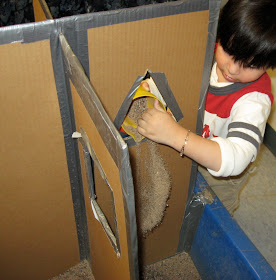A child is transporting through the window into the opposite space. To do that, he has do several operations. First he has to scoop. Without trying to spill, he has to lift the spoon and open the window. He then has to stick the spoon through the window and then turn his wrist to dump. The divider has added more layers of complexity to transporting. What is interesting about this operation is that the child does not see where the material is going. It is blind transporting where something just disappears. That in itself is inviting for the child. This is a good illustration of AXIOM 5 of sensorimotor play seen on the right column.
Here is another example with a little twist.
Note that this divider is a little different than the others pictured so far. When I built this one, I did not have a box with large enough panels to completely divide the areas. In this picture, one panel is lower. That is not an issue for children. They will still come up with their own challenges. The boy in the green is pouring through the hole, but in this case, he is actually reaching over into the middle space on the opposite side where you see the girl in the scarf. He has skipped a space in his work. That is probably his attempt at making the work a little more challenging by seeing how far he can stretch(a good example of trunk extension).
This transporting takes on yet another dimension when a child watches where the material goes.
 Here the child is actually watching himself pour the sand through the hole. He has given himself a target (the pail) into which to pour the sand. Now think about the hand-to-eye coordination task this child has set up for himself. He is pouring the sand through the hole watching from around the divider. The divider cuts off the visual connection between his arm and his hand. He is forced to complete his task by filling in or constructing the pouring motion without a complete visual connection between what he is doing and the result.
Here the child is actually watching himself pour the sand through the hole. He has given himself a target (the pail) into which to pour the sand. Now think about the hand-to-eye coordination task this child has set up for himself. He is pouring the sand through the hole watching from around the divider. The divider cuts off the visual connection between his arm and his hand. He is forced to complete his task by filling in or constructing the pouring motion without a complete visual connection between what he is doing and the result.Here is another example.
The child in this picture does not have a target, but what is striking is that his action is connected even through the divider. He is pouring from one side and on the other side he is using his other hand to help finish the action. He can only watch on one side and he chooses the side where the action is being completed. Though there is a divider, his body action is all connected. Children often do operations like these at a divider between spaces. Very interesting, no?
Take a look at this video for yet another variation of the transporting that takes place with this apparatus.
David opens the window, puts the cup through the window and hangs a measuring cup by its handle on the window. (This hanging of the measuring cup was first introduced to me by a child several years ago and now I use it as a prompt for play.) He takes a scoop of pellets, reaches through the window and pours it into the cup. He opens the window, lifts the cup and pulls it back through the window. He brings the cup around the divider and dumps it in the opposite space. He finishes by showing me his empty cup---maybe proof of all the work he has done? So why would a child go through all the operations to move the pellets into the opposite space when he could have just opened the window and dumped the pellets into that space? It's all about transporting and the need to transport and find as many ways to do it as possible. And in the meantime, he is working on eye-to-hand coordination and other small and large motor developmental tasks.
There is another type of unique play that occurs with the dividers that needs to be highlighted. That is peek-a-boo.
It happens every time the cardboard divider comes out and is a source for lovely social interchanges. That is especially true when the child on the other side is not a usual playmate.




Very cool we will try this tooooo much fun!
ReplyDelete